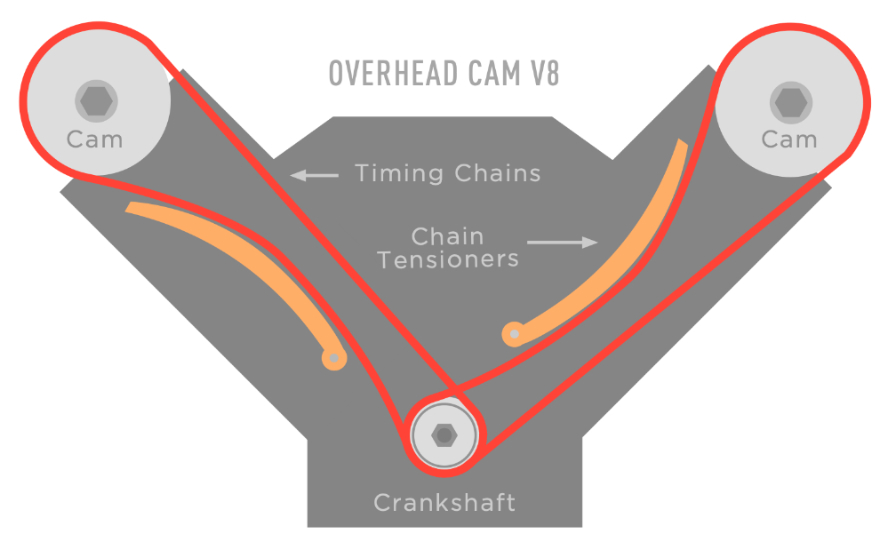
I’M NOT AN AUTOMOTIVE BRAND LOYALIST. I’m loyal to well-engineered, low-trouble vehicles that meet my purposes, whoever makes them. So I’m not writing this as a Chevy driver whose knee-jerk reaction is to bash any and all things Ford. It’s because there are problems with Ford’s 5.4L engine which is used in nearly all its 1997-2014 trucks and vans. I’m writing this so that those who own or are thinking of owning a vehicle with this engine can make informed decisions, know what to be alert for, and take preventive measures. And, worse case, you can know whether a mechanic is making stuff up. I mean, have you ever heard of a cam phaser before?

There are two versions of the Ford 5.4L
The first generation 5.4L, produced from 1997 to 2004, has two valves per cylinder. It is relatively reliable, with only two major faults: excessive timing chain stretch, and spark plugs sometimes blowing out of the cylinder head.
I’ll cover the spark plug issue first. Depending on how you look at it, there are either not enough threads in the spark plug holes, or the spark plugs were too short. These blowouts mangled the threads in the cylinder head.
To address this issue, Ford released a Technical Service Bulletin (TSB) #08-7-6 providing instructions for repairing the damaged spark plug threads, as well as guidelines for installing a new spark plug with an updated design that is less prone to breaking or blowing out. Repairing the spark plug threads requires the labor intensive disassembly and reassembly of the top of the engine.
Chances are, if you have or are considering a vehicle with this engine and it’s still running properly after all these years, the spark plug issue has been repaired. Fingers crossed.
As for the timing chain problem, let me try to explain without getting too technical.
The crank shaft (which is spun by the pistons going up and down) is connected by a chain to the camshaft (which makes the valves open and close). It’s critical for the camshaft to be synchronized to the crankshaft so that the valves open and close at the right time. If the chain stretches as it wears, synchronization is thrown off. That reduces power and fuel efficiency and, in worst cases, allows the pistons and valves to hit each other.
Timing chains are usually very durable, lasting for hundreds of thousands of miles, usually the for the life of the engine. But the timing chain stretch exhibited in the 5.4L engine is excessive and premature and the result of a combination of factors.


The 5.4L is an overhead cam engine. That means instead of a single camshaft in the center of the engine, close to the driveshaft, the camshafts (two in this engine) are at the top of the cylinders. This requires longer timing chains. The longer a chain is, the more susceptible it is to stretch. Each link of a chain might wear a tiny bit, but the more links in a chain, the greater the total wear.
Then there’s the issue of timing chain tensioners. You know how a bicycle chain has a little slop in it unless there’s a spring loaded gizmo taking up the slack? A cam chain tensioner does the same thing. The ones in the 5.4L engine wear out faster than normal because of the material they’re made of. If there’s too much wear in the tensioners the chain might jump a tooth, throwing timing way off and damaging the engine.
(Chain stretch is why many overhead cam engines use toothed belts instead. They don’t stretch, but they eventually rot and break. Pick your poison.)
The second generation 5.4L, produced from 2004 to 2014, has three valves per cylinder. This one has several problems, some of which are related to inadequate oiling.
Upon tearing apart failing engines, mechanics discovered the buildup of sludge and debris clogging the oil passages, particularly in the cylinder heads. Some say the passages are too small. Ford released TSB #07-21-2 recommending that affected engines be cleaned and flushed to remove any debris from the oil passages. In some cases, engines needed to be replaced. Mechanics advised changing oil and filters much more often than recommended in the owner’s manual.
The 5.4L 3-valve engine features Variable Valve Timing (VVT) that can slightly adjust the camshafts on the fly for either greater fuel economy or more power. The camshafts are adjusted with cam phasers. The cam phasers are controlled by oil pressure. See oil pressure problem above. Also see TSB #06-19-8.
On top of this, owners have complained of excessive oil consumption.
The second generation 5.4L also has the timing chain stretch problem.
Conclusions
Some mechanics, such as YouTuber “Car Wizard” who waves a long list of replaced motors, say to never ever EVER buy anything with the 5.4L engine. But to be fair, the mechanics see only a portion of the millions of Fords with these engines. The rest will faithfully serve their owners. If that weren’t true, outraged customers would’ve killed off the engine — and maybe Ford — long ago. The problem is we don’t know which engines will go bad, or when. To repeat what I said at the beginning, I’m writing this so you can make informed decisions, know what to be alert for, and take preventive measures. Also, I’m sharing this so you can see the importance of having enough in your emergency fund to cover a possible engine replacement we hope never happens.

I’ve heard similar specific reports about the Ford Power Stroke diesel. Problems develop, mechanics locate, responsible companies respond with a fix and consumers can make informed choices. Make the prescribed head bolt repair to the mentioned diesel and get many thousands of miles.
Thank you Al. This is an important subject and you did an excellent job explaining. Much appreciated as usual!
Such a beautiful van model / chasis for van-living, too bad the motor is faulty ?; thanks Al for the warnings.
My 2007 expedition with the 5.4 has 484,000 miles. I am still driving it.
I had a 2006 F 150 and the cam phasers started to sound like a 7.3 diesel. I faithfully changed the oil and filter every 3 thousand miles. The truck had 99,000 miles on it. The costs of fixing the cam issue was as much as putting a new engine in so I replaced the engine at $6,000.00. About 20,000 miles later the trans started to have issues so I got rid of it. I do not drive my vehicles hard and the Toyota I had before the F150 had 250,000 miles on it before I gave it to my son it never had a major engine problem.
This is great info. i was wondering why I’ve seen comments to go with the Chevy van rather than the ford. very grateful to you
My opinion, based on the delivery trucks where I work, the Ford seats wear out quickly. Foam goes flat and there’s no support. Kinda important if you’re driving your house.
I recently drove a 2000 F-150 with 190K on it. That seat was great, with excellent lumbar support, which is rather rare.
My 2002 has 280,000 on it, Ive never gone over 3,000 on an oil change, only use FL820S filters and synthetic blend oil and change plugs around 60,000 miles. Its yet to have a single issue.